Osaka Castle Reviews: Exploring Japan’s Historic Fortress
Osaka Castle (Osaka-jo) stands as one of Japan’s most iconic landmarks, offering visitors a deep dive into Japanese history spanning over 400 years. From the warring states period to modern times, this magnificent castle has witnessed countless historical dramas unfold. This guide covers everything you need to know about Osaka Castle—from must-see spots and access information to nearby attractions that will enhance your visit to Osaka.
- What is Osaka Castle? Understanding its Historical Significance
- 6 Must-See Spots at Osaka Castle
- 1. The Main Tower (Tenshukaku) – Experience the View of a Feudal Lord
- 2. Nishinomaru Garden – Seasonal Beauty and Traditional Japanese Gardens
- 3. Sakuramon Gate – Experience an Authentic Castle Gateway
- 4. Sengan Turret (Senganyagura) – Explore Ancient Defensive Architecture
- 5. Tako-ishi (Octopus Stone) – Marvel at Feudal Engineering
- 6. Sanada’s Escape Tunnel – Uncover Samurai Mysteries
- Essential Visitor Information
- 5 Recommended Spots Around Osaka Castle
- Conclusion: Osaka Castle – A Treasure Trove of Japanese Culture
What is Osaka Castle? Understanding its Historical Significance
Osaka Castle was originally built in 1583 by Toyotomi Hideyoshi, the powerful warlord who unified Japan after decades of civil war. Following his death, the castle fell during the famous “Siege of Osaka” against Tokugawa Ieyasu. Later rebuilt during the Edo period under Tokugawa rule, the current main tower was reconstructed in 1931 after surviving several wars and the Meiji Restoration.
The gold-plated castle tower creates a breathtaking sight, especially when illuminated at night. Surrounded by the expansive Osaka Castle Park, this landmark offers not only historical exploration but also seasonal natural beauty that makes it one of Japan’s premier tourist destinations.
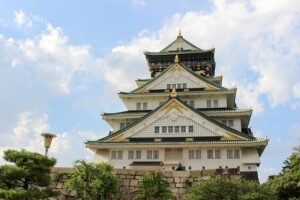
6 Must-See Spots at Osaka Castle
1. The Main Tower (Tenshukaku) – Experience the View of a Feudal Lord
The iconic Main Tower serves as both the symbol of Osaka Castle and a comprehensive museum. Inside this 8-story structure, you’ll find valuable historical artifacts, paintings, and detailed dioramas recreating famous battles from Japan’s warring states period.
From the observation deck on the top floor, you can enjoy a panoramic view of Osaka city—the same view that warlord Hideyoshi would have commanded. The first floor houses a museum shop where you can purchase unique samurai-themed souvenirs and other Japanese memorabilia.
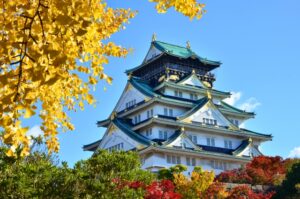
2. Nishinomaru Garden – Seasonal Beauty and Traditional Japanese Gardens
Originally the site where Hideyoshi’s wife Nene resided, Nishinomaru Garden is famous for its approximately 300 cherry trees that create a spectacular display during spring. The garden offers perfect photo opportunities with the castle tower as a backdrop against the cherry blossoms.
The garden also features a traditional tea house donated by Konosuke Matsushita (founder of Panasonic), where you can appreciate authentic Japanese garden aesthetics and the art of borrowed scenery.
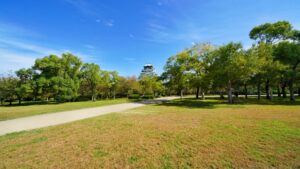
3. Sakuramon Gate – Experience an Authentic Castle Gateway
Sakuramon (Cherry Blossom Gate) serves as the main entrance to the inner bailey of Osaka Castle and is designated as an Important Cultural Property of Japan. With its imposing white walls and black-lacquered doors, the gate provides a tangible connection to Japan’s feudal past and makes for a popular photo spot.
Just beyond the gate stands Hokoku Shrine, dedicated to Toyotomi Hideyoshi. The shrine is believed to bring good fortune in career advancement and victory—reflecting Hideyoshi’s own rise from a farmer to Japan’s supreme ruler.
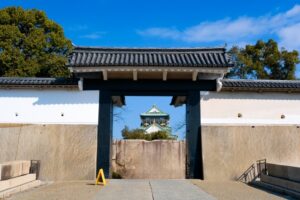
4. Sengan Turret (Senganyagura) – Explore Ancient Defensive Architecture
Considered the oldest surviving structure within Osaka Castle, the Sengan Turret played a crucial role in the castle’s defense system. Perched atop stone walls, this white-walled turret exemplifies the strategic military architecture of feudal Japan.
Inside, you can observe the solid pillars and beams, along with small windows that were once used by defenders to monitor approaching enemies. The turret offers insight into how Japanese castles functioned as military fortresses.
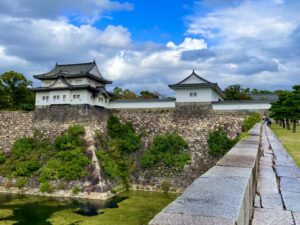
5. Tako-ishi (Octopus Stone) – Marvel at Feudal Engineering
Located just past the Sakuramon Gate, the Tako-ishi (Octopus Stone) is a massive boulder positioned as part of the castle’s defenses during the Tokugawa reconstruction. This enormous stone covers an area equivalent to about 36 traditional Japanese tatami mats (approximately 60 square meters).
Together with the adjacent Furisode-ishi (Kimono Sleeve Stone), these impressive rocks cover about 69 tatami mats in total, showcasing the remarkable engineering capabilities of feudal Japan in moving and positioning such massive stones without modern machinery.
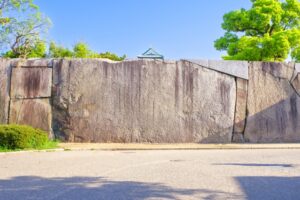
6. Sanada’s Escape Tunnel – Uncover Samurai Mysteries
Located at Sanko Shrine south of Osaka Castle, this mysterious tunnel has several competing historical theories. Some believe it served as a communication route for Toyotomi forces, while others suggest it was an infiltration path for Tokugawa troops during the siege.
The stone entrance emanates a mystical atmosphere that transports visitors back to Japan’s tumultuous warring states period. The tunnel’s true purpose remains debated by historians, adding an element of mystery to your visit.
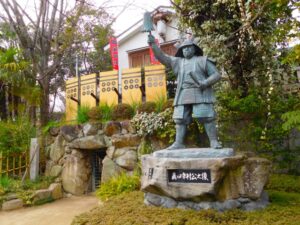
Essential Visitor Information
Opening Hours and Admission Fees
- Opening Hours: 9:00 AM – 5:00 PM (last admission at 4:30 PM) Extended until 6:00 PM during cherry blossom season and summer holidays
- Closed: December 28 – January 1
- Admission Fee: Adults: 600 yen, Junior high school students and younger: Free (ID required)
Best Seasons to Visit
- Spring (late March to early April): Cherry blossom season offers stunning views of the castle framed by pink blossoms
- Summer: Enjoy boat cruises in the moat surrounding the castle
- Fall: Beautiful autumn foliage with fewer crowds
- Winter: The castle against crisp winter skies creates a serene atmosphere
5 Recommended Spots Around Osaka Castle
After exploring Osaka Castle, make time to visit these nearby attractions to experience more of what Osaka has to offer.
1. Dotonbori – Osaka’s World-Famous Entertainment District
This vibrant district in Osaka’s Minami area is known for its unique billboards, including the famous Glico running man sign and giant pufferfish sculptures. Dotonbori is lined with restaurants serving Osaka specialties like takoyaki (octopus balls), kushikatsu (fried skewers), and crab dishes.
For an evening adventure, the Tombori River Cruise offers a different perspective of the neon-lit district from the water.
- Access: Directly accessible from Osaka Metro “Namba” Station

2. Abeno Harukas – Spectacular Views from Japan’s Tallest Building
Standing approximately 300 meters tall, Abeno Harukas is the tallest building in Japan. The “Harukas 300” observation deck on the 60th floor offers breathtaking views of Osaka city, with visibility extending to Kyoto and Kobe on clear days.
The 58th floor features cafes where you can enjoy meals with panoramic views. The building also houses an art museum, hotel, and department store.
- Hours: 9:00 AM – 10:00 PM (last entry 9:30 PM)
- Admission: Adults: 2,000 yen, Junior/Senior high school students: 1,200 yen, Elementary school students: 700 yen
- Access: Directly connected to Osaka Metro/JR “Tennoji” Station or Kintetsu “Abenobashi” Station
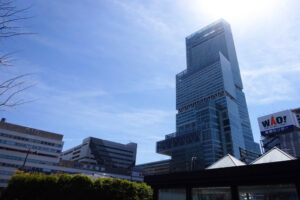
3. Tsutenkaku Tower – Experience Osaka’s Downtown Culture
Known as the symbol of the nostalgic Shinsekai district, Tsutenkaku Tower has a history spanning about 100 years. The 5th-floor observation deck features the “Billiken” deity of good fortune—touching his feet is said to bring luck.
The surrounding area preserves the atmosphere of mid-20th century Osaka, offering affordable local delicacies like kushikatsu fried skewers.
- Hours: 10:00 AM – 8:00 PM (last entry 7:30 PM)
- Admission: Adults: 1,000 yen, Children: 500 yen
- Access: 3-minute walk from Osaka Metro Sakaisuji Line “Ebisucho” Station
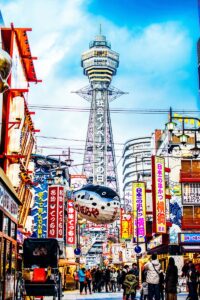
4. Kuromon Market – Osaka’s Kitchen for Food Adventures
Known as “Osaka’s Kitchen,” Kuromon Market features approximately 150 shops selling everything from fresh seafood and produce to ready-to-eat local specialties. This is the perfect place for food enthusiasts to sample Osaka’s culinary offerings.
Popular street foods include takoyaki, kushikatsu, grilled tuna skewers, and more—all prepared right before your eyes at storefront kitchens.
- Access: About 5 minutes walk from Osaka Metro Sennichimae Line “Nipponbashi” Station
5. Miraiza Osaka-jo – Dine with Castle Views
Located within Osaka Castle Park, Miraiza Osaka-jo is housed in a renovated building that once served as an army headquarters. With its European medieval-inspired architecture, the facility now contains restaurants, cafes, and shops.
The rooftop restaurant offers dining with impressive views of the castle tower. The venue also hosts cultural experiences such as samurai and ninja workshops, making it a great place to immerse yourself in Japanese culture.
- Hours: 9:00 AM – 6:00 PM
- Access: About 15 minutes walk from JR “Morinomiya” Station or “Osakajokoen” Station
Conclusion: Osaka Castle – A Treasure Trove of Japanese Culture
Osaka Castle is far more than just a tourist attraction—it’s a place where you can experience Japan’s rich history and culture firsthand. From the panoramic views from the main tower to the beautiful gardens and historical structures, there is no shortage of fascinating sights.
The surrounding area offers everything from modern skyscrapers to traditional markets, allowing you to experience both the old and new faces of Osaka in one visit.
Make sure to include Osaka Castle in your Japan itinerary to experience the history, culture, and vibrant energy that makes Osaka unique. It’s sure to be an unforgettable highlight of your journey through Japan.
Note: Please check the official website for the latest information on opening hours and admission fees before your visit. Hours and fees may change during special events or seasons.


